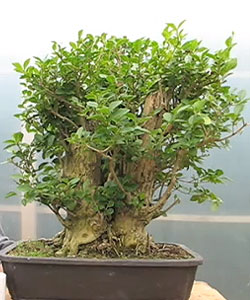
In this tutorial, you will see how to transform an ugly hedging material into a beautiful bonsai by using deadwood carving techniques and some branch wiring.
We’ll be using Privet Tree, scientific name Ligustrum ovalfolium which is a plant that is widely used for hedging. It has been in this pot for about 4 years.
During that time, it has been pruned very frequently resulting in a dense branch structure. The natural habit of this tree is very long and straight branches. In order to create a bonsai from it, we’ll need to do some wiring.
Despite looking like a promising material, this tree is not as great as it looks. There are several long unattractive trunks that are all coming from one base. If you rotate this tree, it looks flat from any direction. There is no depth since all of these trunks are coming at you.
In order to style this tree, we’ll need to use a carving technique and get a lot of these straight away. There is quite a lot of natural dieback, which will allow us to do something more interesting without stripping out too much wood.
The main thing is to use the carving technique to create a profile of the trunk. We’ll need to remove some large pieces of the trunk. Once we get down to that basic trunk form, we’ll be able to use wire to shape branches to highlight that trunk.
Since the Privet tree is a member of the Olive family, it is a very robust tree. You can pretty much do anything and any time of the year to this tree and it will survive. Because it is very hard to kill this tree, it’s a great material for beginners. Today’s goal is to lay a basic groundwork for what will become a bonsai in the future.
Items you will need:
- Shears – Regular shears that will be used to trim small branches.
- Concave Branch Cutter – Use it to cut branches.
- Bonsai Wire Cutters – You will need to cut wire with these.
- Makita Carving Tool
– Makita is perfect for working on bonsai. Operation is super smooth and ergonomics are very comfortable.
- Diamond Tip Carving Burr
– This 120-piece set offers 30 profiles in four grits, 150, 240, 400, and 600, so you can progress from rapid cutting to final finishing cuts with the same profile.
- Brown Anodized Aluminum Wire – It will be used for wiring branches. I like to use this type of wire because it has an anodized coating which protects the wire from corrosion. It is also easier to apply than copper and blends in with the bark very well.
- Lime Sulphur – Will be used to protect the deadwood. It will also brighten up the deadwood.
- Electrical Saw – Will be used to cut thick trunks.
Here is a step-by-step video
Step 1: Trimming the trunks
At this point, you should decide where the front of your bonsai is going to be. Smaller trunks are too straight and not that interesting, so we can remove them.
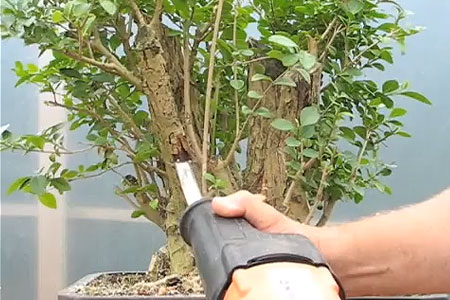
Right away you can see how the tree has opened up.
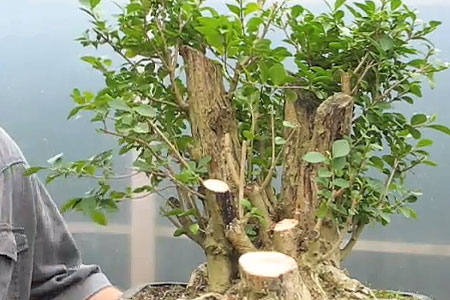
Now, we are left with twin trunks. The tree will look less interesting if both of the trunks are the same height. Therefore, one of the trunks needs to be shorter than the other. Using a powered handsaw remove a few inches of the left trunk.
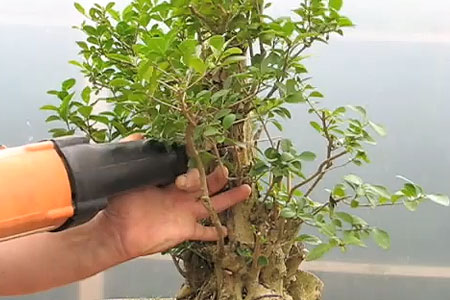
Step 2: Carving
After removing extra trunks the proportions of the tree have improved, but it still looks very ugly. We also want to create an illusion of age by removing a lot of the cuts and cleaning up the bark.

Use a bonsai carving tool to do heavy carving. Start by working on those awful-looking cuts at the bottom of the tree that were left after we’ve removed smaller trunks.
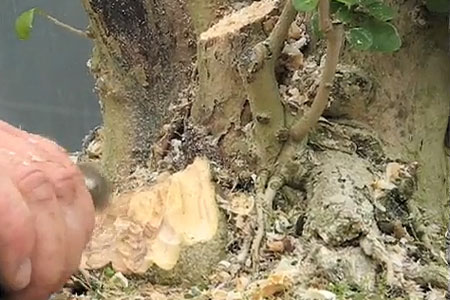
Step 3: Creating ‘Jin’ and ‘Uro’
We can give an aged look to one of the smaller stumps, that was cut in front of the tree, by making it into a ‘Jin which means a dead branch/trunk stripped of bark. Creating a Jin is not an easy project especially since this trunk is straight and featureless.
A successful Jin should look natural and complement the tree. To create a jin you would usually pull away a segment of the stump with regular pliers. Since we need to remove a lot of the wood from all of the trunks, we’ll be using a power tool.
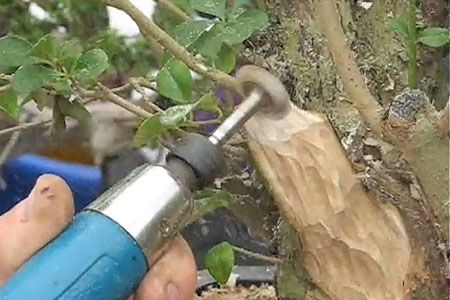
By carving it with a power tool we want to mimic the action of a broken branch. We can also add some interest by creating a ‘Uro’ within it. ‘Uro’ means a hollow in the tree.
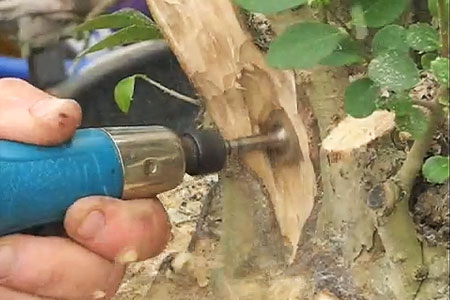
When creating a hollow in the tree, make sure it has a random shape. If it is perfectly round, it will look unnatural and man-made. When carving, follow the grain of the wood. Small flaws uncovered during carving can be enhanced and become features of the tree.
Step 4: Creating ‘Sabamiki’
Now, we are left with two unattractive stumps. To disguise the lack of taper, we can create ‘Sabamiki’ which means hollow trunk. Adding ‘Uro’ to the trunks will add some interest.
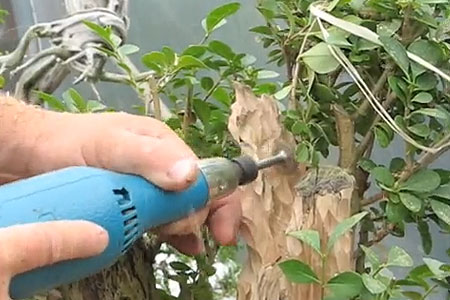
There are really no rules when it comes to creating the deadwood effect. The result depends on your imagination. The best way to produce interesting output is by studying and mimicking the trees around you.
Have fun, use your imagination, and don’t be afraid to make a mistake. Creating deadwood takes a lot of time and practice.
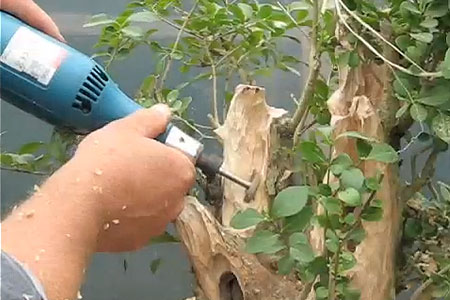
As you can see, both small stumps in front of the tree are now a part of the whole composition.
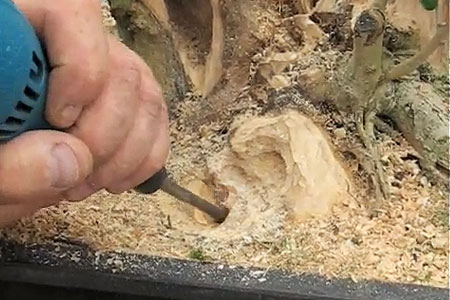
Step 5: Add some details
Use a smaller burr to add details to the wood. Remember, you are trying to make it look natural and not man-made. In this step, focus on blending in tool marks and enhancing features of the wood.
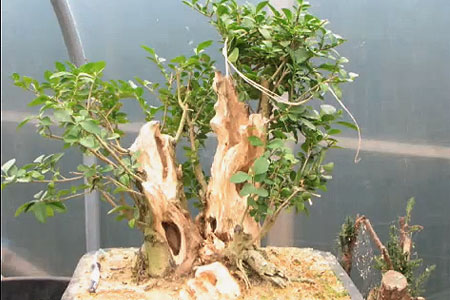
The trunk on the right is turned into a Jin with a hollow. It looks very natural and complements the main trunks.
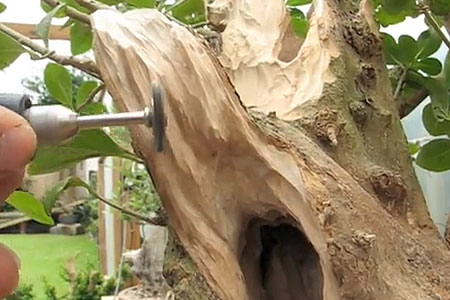
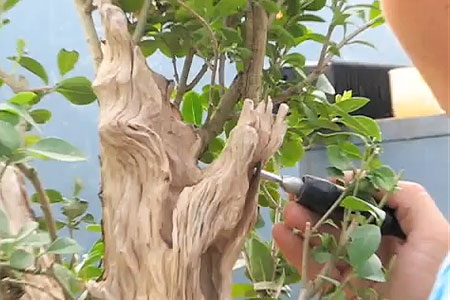
Step 4: Applying Lime Sulfur
Lime Sulfur is used to protect deadwood from rotting. It will also lighten the deadwood giving it a sun-bleached effect. When dealing with lime sulfur, protect yourself by wearing gloves and a long-sleeved shirt.
Use a soft paintbrush to apply lime sulphur to the deadwood. For lime sulfur to absorb better, spray the area with water first and let it sit for 15 minutes before applying.
In some cases, you might want to add some color to the wood. You can do it by adding a color pigment to the lime sulfur. You can also try adding acrylic paints that are water-based, coffee, or tea.
Step 5: Wiring Branches
You want to give this tree a good branch structure with a clear separation between branches. The goal is to create little pads of foliage. To do that we need to keep the main branches and remove all the secondary branches that are in between.
Since Privet has a very straight branch structure, we need to change the position of the branches by bringing them down and positioning them more parallel to the ground. I like to use brown anodized aluminum wire because it is very easy to apply and it blends in with the rest of the tree very well.
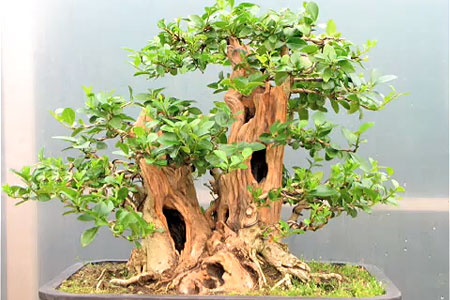
Related articles:
